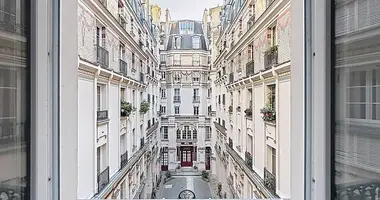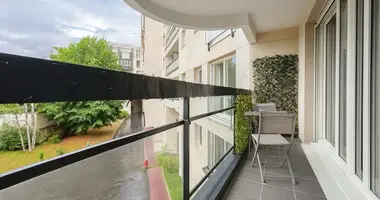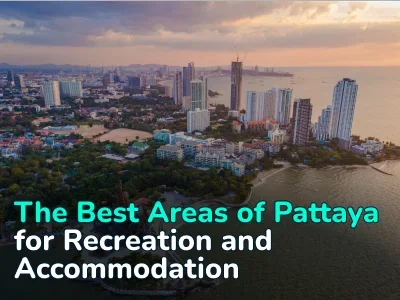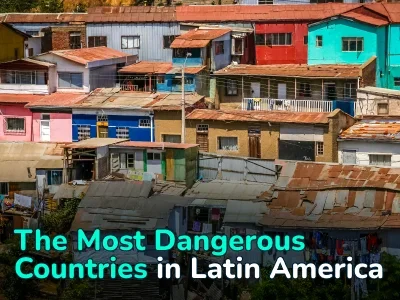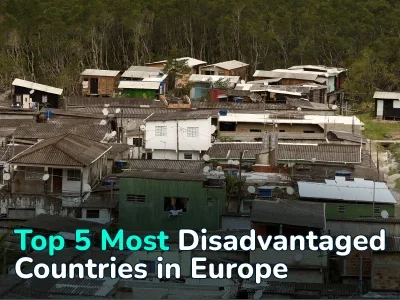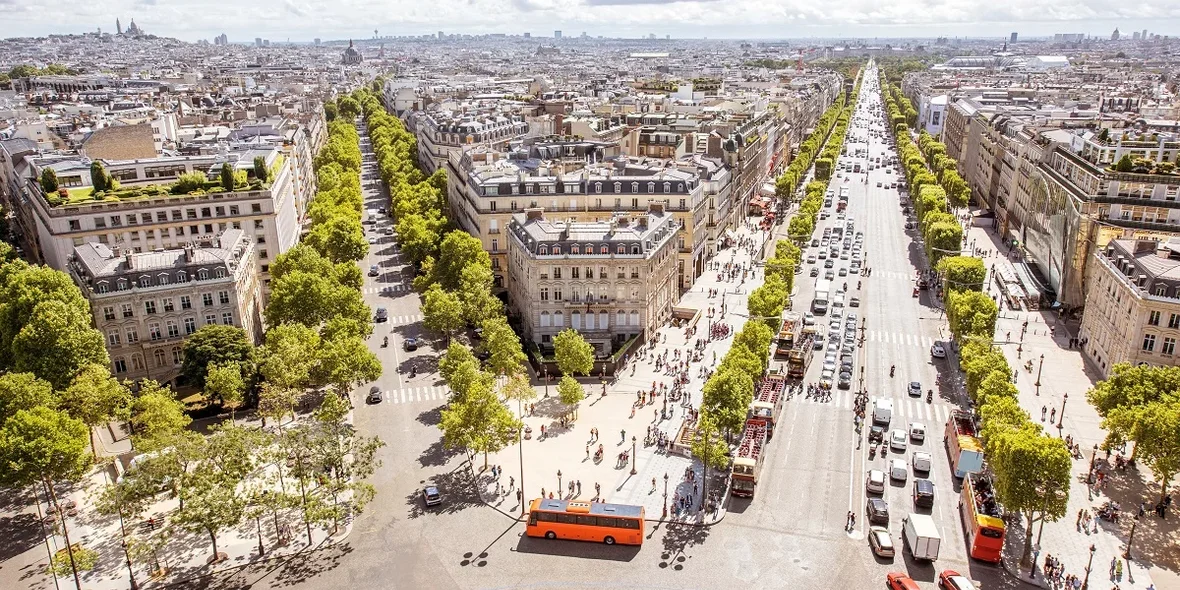
Which is the Best Arrondissement to Live in Paris? A Guide to the Safest and Most Dangerous Neighborhoods
Are you planning to live in Paris but don’t know which area to choose? We found out which districts of the French capital are considered the safest and vice versa, where you can find housing in Paris at the most affordable prices, and which districts are best for living if you are a student, a young professional, or a family.
What is the Best District to Live in Paris?
Paris is divided into 20 arrondissements, each with its own unique atmosphere, infrastructure, and cost of living. The choice of area depends on your budget, lifestyle, family status, and transport preferences.
Best Districts for Families
Passy (16th arrondissement)
A prestigious and safe area, popular with families, as it is quiet, has good schools (including international ones), and is close to the Bois de Boulogne. Rental prices: 30–45 €/m², purchase: 14,000–16,000 €/m².
Batignolles-Monceau (17th arrondissement)
Why it is good for families: relatively affordable prices, parks (Parc Martin Luther King) and quality schools. Rental prices: 25–35 €/m², purchase: 11,500–14,000 €/m².
Gros-Caillou (7th arrondissement)
A safe central area with prestigious schools and the Eiffel Tower within walking distance. Expensive to live in: rent €35—50/m², buy €15,000—18,000/m².
Neuilly-sur-Seine (suburb)
A safe suburb with green districts and good schools. Rent: €20—30/m², buy: €9,000—12,000/m². The journey to the centre takes 20–40 minutes.
Нёйи-сюр-Сен (пригород)
An upmarket suburb popular with wealthy families. Rent: €22—35/m², buy: €10,000—13,000/m². Convenient public transport links.
Best Districts for Young Professionals
Marais (4th arrondissement)
Trendy, central area with a vibrant nightlife, galleries, and cafés. Rent: €30—45/m², purchase: €13,000—16,000/m².
Canal Saint-Martin (10th and 11th arrondissements)
Creative area with bars and a promenade. Can be noisy. Rent: €20—30/m², purchase: €9,500—12,000/m².
Place de la Bastille (11th arrondissement)
Lively area with nightlife and affordable prices. Rent: €20—30/m², purchase: €9,500—12,000/m².
Oberkampf (11th arrondissement)
A multicultural, trendy area with bars and restaurants. Rent: €20—30/m², purchase: €9,500—12,000/m².
Belleville (19th and 20th arrondissements)
A diverse and affordable area popular with artists. Rent: €15—25/m², purchase: €8,500—10,500/m².
Best Districts for Expats
Marais (4th arrondissement)
Expat-friendly due to its location and widespread English language skills.
Saint-Germain-des-Prés (6th arrondissement)
A prestigious area with cafes, galleries, and international schools. Rent: €35—50/m², purchase: €15,000—20,000/m².
Place de la Bastille (11th arrondissement)
Affordable and lively, suitable for young expats.
Oberkampf (11th arrondissement)
Creative atmosphere, popular with expats.
Passy (16th arrondissement)
Safe and upscale, with international schools, ideal for expats with families.
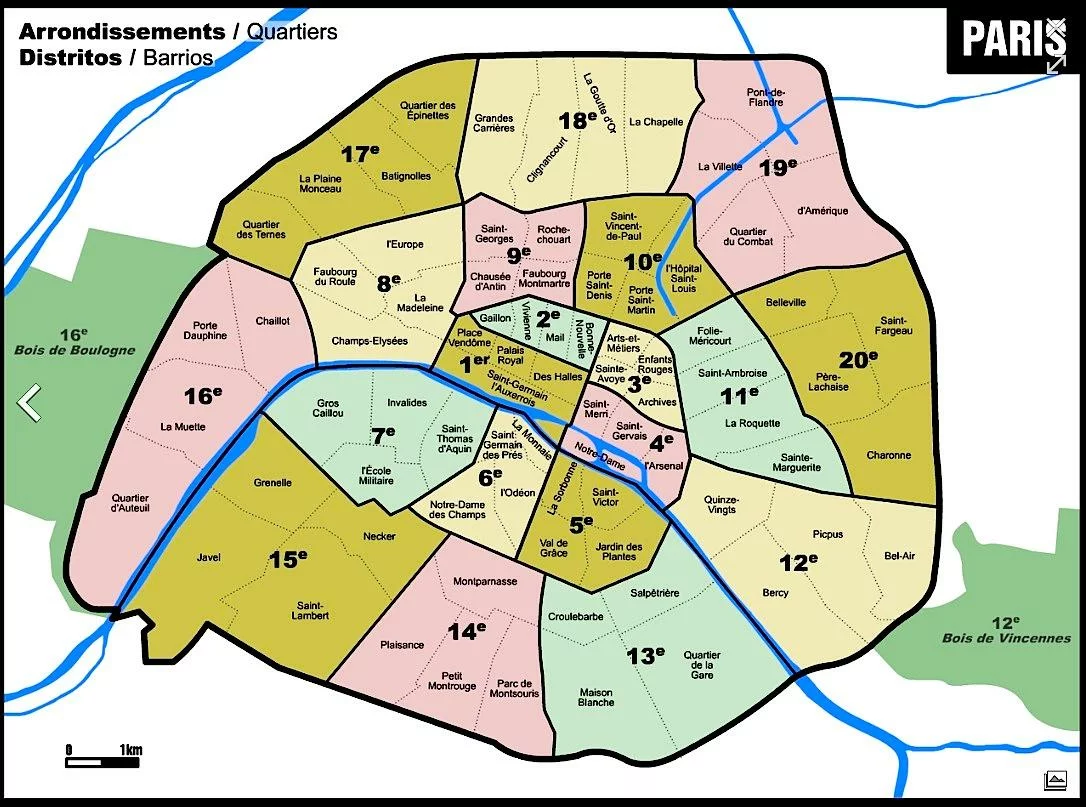
ComparativeTable of Paris Districts
What to consider when choosing a district in Paris:
- Budget. Prices for renting and buying a home vary greatly. In 2025, the average rental price in Paris is €25—50/m², while buying is €8,500—20,000/m² (depending on the arrondissement).
- Lifestyle. The central districts (1–8) are lively, and the outskirts (12–20) are quieter.
- Marital status. Families tend to value schools and parks, while young people value nightlife and transportation.
- Transport links. Paris has an excellent metro network, but travel times from the suburbs can sometimes be inconvenient.
- Infrastructure. Evaluate the availability of parks, shops, restaurants and cultural attractions.
So, here is the table:
|
District |
Convenient for… |
Pros |
Cons |
|
Passy (16th arrondissement) |
Families, expats. |
Safe, elite, good schools, Bois de Boulogne. |
Expensive (rent 30–45 €/m², purchase 14,000–16,000 €/m²). |
|
Batignolles-Monceau (17th arrondissement) |
Families, young professionals. |
Good schools, parks, relatively accessible. |
Prices are rising (rent 25–35 €/m², purchase 11,500–14,000 €/m²). |
|
Gros-Caillou (7th) |
Families, expats. |
Safe, central, close to the Eiffel Tower. |
Very expensive (rent 35–50 €/m², purchase 15,000–18,000 €/m²). |
|
Boulogne-Billancourt |
Families, expats. |
Safe, green areas, good schools. |
Far from the center (20–40 min), rent 20–30 €/m², purchase 9,000–12,000 €/m². |
|
Neuilly-sur-Seine |
Families, expats. |
Safe, prestigious, good schools. |
Far from the center, rent 22–35 €/m², purchase 10,000–13,000 €/m². |
|
Mare (4th) |
For young professionals, expats. |
Fashionable, central, diverse. |
Quite expensive (rent 30–45 €/m², purchase 13,000–16,000 €/m²). |
|
Canal Saint Martin (10th, 11th) |
For young professionals, artists. |
Trendy, lively, waterfront. |
Noisy, rent 20–30 €/m², purchase 9,500–12,000 €/m². |
|
Place de la Bastille (11th) |
For young professionals, families, expats. |
Central, active nightlife, accessible. |
Noisy, rent 20–30 €/m², purchase 9,500–12,000 €/m². |
|
Oberkampf (11th) |
For young professionals, artists. |
Trendy, multicultural, accessible. |
Noisy, rent 20–30 €/m², purchase 9,500–12,000 €/m². |
|
Belleville (19th, 20th) |
For young professionals, artists, students. |
Accessible, multicultural, trendy. |
Noisy, less safe, rent 15–25 €/m², purchase 8,500–10,500 €/m². |
|
Menilmontant (20th) |
Families, young professionals. |
Affordable, vibrant nightlife, parks. |
Noisy, rent 15–25 €/m², purchase 8,500–10,500 €/m². |
|
Pere Lachaise (20th) |
Families, young professionals. |
Historical, accessible, multicultural. |
Noisy, rent 15–25 €/m², purchase 8,500–10,500 €/m². |
|
Sharon (20th) |
Families, young professionals. |
Accessible, nice parks, calm atmosphere. |
Far from the center, rent 15–25 €/m², purchase 8,500–10,500 €/m². |
|
Gambetta (20th) |
Families, young professionals. |
Affordable prices, good schools, and transportation. |
Less prestigious, rent 15–25 €/m², purchase 8,500–10,500 €/m². |
Which Arrondissement of Paris is the Safest?
The safest arrondissements in Paris are 1st, 2nd, 5th, 6th, 7th, 8th, 16th, 17th. These areas have low crime rates, but pickpocketing in tourist areas (e. g., Louvre, Champs-Élysées) remains a problem.
According to the latest data, Paris has become safer since the 2024 Olympics, with an overall crime rate of 110.5 per 1,000 inhabitants (235,666 reported crimes). However, Paris remains one of the most crime-ridden cities in France (3rd place after Lille and Bordeaux).
Paris arrondissements ranked by security:
|
District |
Rating |
Note |
|
1st |
Very safe |
City center (Louvre, Tuileries). Low crime rate, but lots of pickpockets. |
|
2nd |
Safe |
Business district, tourist. Pickpocketing in the Opera district. |
|
3rd |
Moderately safe |
Marais, galleries, nightlife. Rare cases of theft and assault. |
|
4th |
Moderately safe |
Notre Dame, Bastille. Safe, but pickpocketing in tourist areas. |
|
5th |
Very safe |
Latin Quarter, students. Low crime rate, rare thefts. |
|
6th |
Very safe |
Saint-Germain-des-Prés, Luxembourg Gardens. Safe, but tourists attract thieves. |
|
7th |
Very safe |
Eiffel Tower, Rodin Museum. Low crime, pickpockets at landmarks. |
|
8th |
Very safe |
Champs Elysees, Arc de Triomphe. Safe, but pickpocketing. |
|
9th |
Moderately safe |
Opera Garnier, Galeries Lafayette. Pickpocketing and fraud. |
|
10th |
Moderately safe |
Canal Saint-Martin, train stations (Gare du Nord, Gare de l'Est). Attacks and thefts. |
|
11th |
Moderately safe |
Oberkampf, Bastille. Nightlife, but occasional thefts and assaults. |
|
12th |
Moderately safe |
Bois de Vincennes, Bercy Village. Safe, but rare thefts. |
|
13th |
Moderately safe |
Asian Quarter, National Library. Rare thefts and assaults. |
|
14th |
Moderately safe |
Parc Montsouris, student district. Rare thefts and assaults. |
|
15th |
Moderately safe |
Park Andre Citroen, residential area. Relatively safe, rare thefts. |
|
16th |
Very safe |
Bois de Boulogne, Roland Garros. Very safe, elite area. |
|
17th |
Very safe |
Residential area, Batignolles. Low crime rate. |
|
18th |
Moderately safe |
Montmartre, Sacre Coeur. Touristy, but pickpocketing and fraud do occur. |
|
19th |
Moderately safe |
Parc des Buttes-Chaumont, City of Science. Safe, but thefts in areas such as Stalingrad. |
|
20th |
Moderately safe |
Belleville, Menilmontant. Varied, occasional thefts and assaults. |
The Most Dangerous Arrondissements of Paris
Paris remains a relatively safe city, but some areas require caution, especially at night. The current list:
- Gare du Nord (10th arrondissement): the station area is known for pickpocketing, fraud and prostitution.
- Barbès-Rochechouart (18th arrondissement): a high-crime area with street crime.
- Porte de Clignancourt (18th arrondissement): flea market area, unsafe at night.
- Seine-Saint-Denis (suburb): high crime and poverty. Not part of Paris, but close.
- Place de la Battle of Stalingrad and Porte de la Villette (19th arrondissement): drug trafficking and petty crime problems.
- Banane, Saint-Blaise, parts of Belleville (20th arrondissement): less safe areas with occasional thefts.
- Porte de Pantin (10th and 11th arrondissements): gentrification area, but with persistent problems.
Latest safety tips for Paris:
- Be careful in crowded places (metro, Louvre, Eiffel Tower). Pickpocketing remains the main threat.
- Avoid walking alone at night in the above areas.
- Keep valuables in safe places, and use licensed taxis (e. g., G7, Uber).
- Check the address of the hotel or apartment to avoid crime zones.
Where do Rich People Live in Paris?
Wealthy residents prefer the following districts:
- 7th arrondissement. The most expensive, with the Eiffel Tower and embassies. Purchase: €15,000—18,000/m², rent: €35—50/m².
- 8th arrondissement. Champs-Élysées, luxury shops. Purchase: €14,500—17,000/m², rent: €32—48/m².
- 16th arrondissement. Prestigious, with the Bois de Boulogne. Purchase: €14,000—16,000/m², rent: €30—45/m².
- 6th arrondissement. Saint-Germain-des-Prés, Luxembourg Gardens. Purchase: 15,000–20,000 €/m², rent: 35–50 €/m².
Expensive streets:
- Rue Guynemer (6th arrondissement). Near the Luxembourg Gardens, purchase €20,000—25,000/m².
- Rue de Verneuil (7th arrondissement). Saint-Thomas d’Aquin, purchase €18,000—22,000/m².
- Avenue Montaigne (8th arrondissement). Luxury shops, purchase €17,000—27,000/m².
Cheapest Areas to Live in Paris
Paris has become safer since the 2024 Olympics, but rental prices have risen by 5-10%. The central areas have become especially expensive.
The 17th arrondissement is gaining popularity as an alternative to the expensive 16th. The 10th and 11th arrondissements continue to gentrify — prices are rising, but still remain affordable.
The 20th arrondissement remains the most affordable, with rents of 15-25 €/m² and purchases of 8,500-10,500 €/m². Well connected to the center by metro (lines 2, 3, 11). Popular neighborhoods:
- Belleville: multicultural, affordable, with cafes and parks.
- Menilmontant: vibrant nightlife, affordable housing.
- Saint-Fargeau: calm, with green areas.
- Père Lachaise: historic, with the Père Lachaise cemetery.
- Charonne: calm, with parks and low prices.
Other affordable arrondissements to live in:
- 19th arrondissement. Rent €16—26/m², purchase €8,700—10,600/m². Parc des Buttes-Chaumont, City of Sciences.
- 12th arrondissement. Rent €18—28/m², purchase €9,000—11,500/m². Bois de Vincennes, Bercy Village.
- 13th arrondissement. Rent €18—28/m², purchase €9,000—11,500/m². Asian Quarter, National Library.
Current average rental prices:
|
District |
Price |
Features |
|
20th |
15-25 |
The most affordable |
|
19th |
16-26 |
Affordable |
|
12-13th |
18-28 |
Budget |
|
10-11th |
20-30 |
Average |
|
9th |
22-35 |
Higher than average |
|
17th |
25-35 |
Increasing |
|
3-4th |
30-45 |
Expensive |
|
16th |
30-45 |
Prestigious |
|
8th |
32-48 |
Elite |
|
1-2th |
35-50 |
Central |
|
5-7th |
35-50 |
The most expensive |
Current average purchase prices (thousands of euros per m²):
|
Category |
Districts |
Price |
|
Affordable |
19-20th |
8,5-10,5 |
|
Middle segment |
10-13th |
9,5-12 |
|
Expensive |
3-4th, 16-17th |
13-16 |
|
Elite |
6-8th |
15-18 |
|
Luxurious |
Best streets of the 6-7th districts |
20-27 |
What to consider when buying real estate in Paris:
- Housing is sold out in 1–3 days — prepare documents in advance.
- Income certificates and a guarantor are required.
- Agents charge a commission equal to a month’s rent or 2-5% of the purchase price.
Residential properties for sale in Paris, France
Frequently Asked Questions About Paris Districts
Which districts of Paris are the safest to live in?
The safest arrondissements of Paris are the 1st, 2nd, 5th, 6th, 7th, 8th, 16th and 17th. These districts, including Passy and Saint-Germain-des-Prés, have low crime rates, but pickpocketing is possible in tourist districts such as the Louvre or the Champs-Élysées.
Where are the cheapest districts to rent in Paris?
The most affordable arrondissement is the 20th (Belleville, Menilmontant, Père Lachaise), with rents ranging from 15–25 €/m². Also inexpensive are the 19th (16–26 €/m²) and 12th (18–28 €/m²). These districts offer budget accommodation and good public transport links.
Which districts of Paris are best for families?
For families, Passy (16th), Batignolles-Monceau (17th) and Gros-Caillou (7th) are ideal due to their safe environment, schools and parks. The suburbs of Boulogne-Billancourt and Neuilly-sur-Seine are also popular.
Which districts of Paris are good for young professionals and expats?
For young professionals, the Marais (4th), Canal Saint-Martin (10th and 11th), and Oberkampf (11th) are trendy districts with a vibrant nightlife. Expats often choose the Marais, Saint-Germain-des-Prés (6th), and Passy (16th).
Where do rich people live in Paris?
Wealthy residents choose the 7th arrondissement (Eiffel Tower, €15,000—€18,000/m²), 8th (Champs-Élysées, €14,500—€17,000/m²) and 16th (Passy, €14,000—€16,000/m²). Exclusive streets: Rue Guynemer (€20,000—€25,000/m²), Avenue Montaigne.
Which districts of Paris are best to avoid?
Avoid Gare du Nord (10th arrondissement), Barbès and Porte de Clignancourt (18th arrondissement) at night due to pickpocketing and street crime. Seine-Saint-Denis (suburb) and Place de la Battle of Stalingrad (19th arrondissement) are also considered less safe.
How much does it cost to rent in Paris?
Average rents range from 15–25 €/m² in the 20th arrondissement to 35–50 €/m² in the 7th and 6th arrondissements. The central districts are more expensive, while the eastern ones are more affordable.
Which arrondissement of Paris is best for students?
Students will find the 20th arrondissement (Belleville, Menilmontant, 15–25 €/m²) and the 19th arrondissement (16–26 €/m²) to be affordable and close to the metro. The Latin Quarter (5th arrondissement) is popular, but will be more expensive (35–50 €/m²).
How to stay safe in Paris?
Be careful in crowded places, do not walk alone at night in districts such as Gare du Nord or Barbès. Keep your valuables safe and use licensed taxis (G7, Uber).
Author
I am responsible for editorial work. I write expert interviews and guides.








